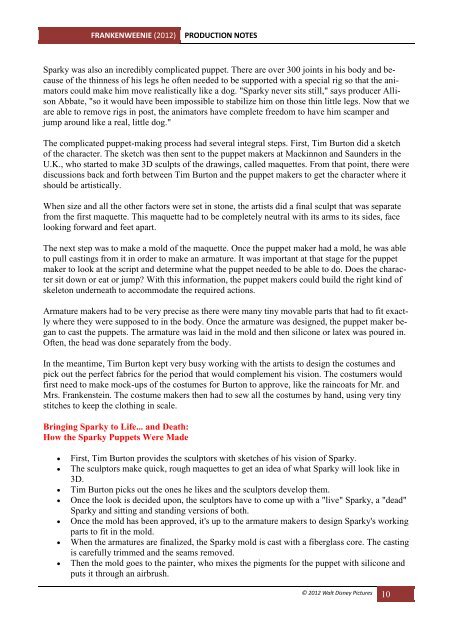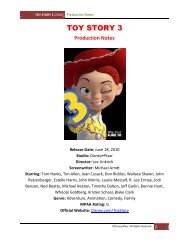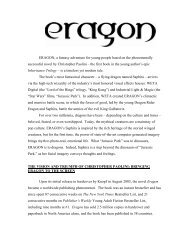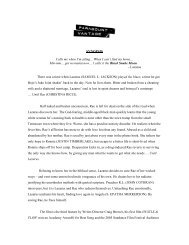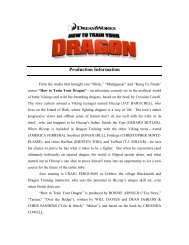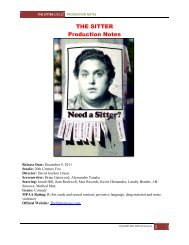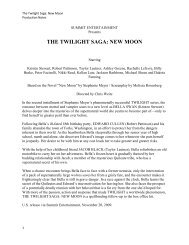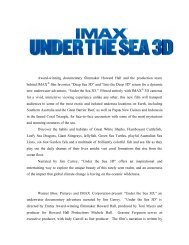FRANKENWEENIE Production Notes - Visual Hollywood
FRANKENWEENIE Production Notes - Visual Hollywood
FRANKENWEENIE Production Notes - Visual Hollywood
Create successful ePaper yourself
Turn your PDF publications into a flip-book with our unique Google optimized e-Paper software.
<strong>FRANKENWEENIE</strong> (2012)PRODUCTION NOTESSparky was also an incredibly complicated puppet. There are over 300 joints in his body and becauseof the thinness of his legs he often needed to be supported with a special rig so that the animatorscould make him move realistically like a dog. "Sparky never sits still," says producer AllisonAbbate, "so it would have been impossible to stabilize him on those thin little legs. Now that weare able to remove rigs in post, the animators have complete freedom to have him scamper andjump around like a real, little dog."The complicated puppet-making process had several integral steps. First, Tim Burton did a sketchof the character. The sketch was then sent to the puppet makers at Mackinnon and Saunders in theU.K., who started to make 3D sculpts of the drawings, called maquettes. From that point, there werediscussions back and forth between Tim Burton and the puppet makers to get the character where itshould be artistically.When size and all the other factors were set in stone, the artists did a final sculpt that was separatefrom the first maquette. This maquette had to be completely neutral with its arms to its sides, facelooking forward and feet apart.The next step was to make a mold of the maquette. Once the puppet maker had a mold, he was ableto pull castings from it in order to make an armature. It was important at that stage for the puppetmaker to look at the script and determine what the puppet needed to be able to do. Does the charactersit down or eat or jump? With this information, the puppet makers could build the right kind ofskeleton underneath to accommodate the required actions.Armature makers had to be very precise as there were many tiny movable parts that had to fit exactlywhere they were supposed to in the body. Once the armature was designed, the puppet maker beganto cast the puppets. The armature was laid in the mold and then silicone or latex was poured in.Often, the head was done separately from the body.In the meantime, Tim Burton kept very busy working with the artists to design the costumes andpick out the perfect fabrics for the period that would complement his vision. The costumers wouldfirst need to make mock-ups of the costumes for Burton to approve, like the raincoats for Mr. andMrs. Frankenstein. The costume makers then had to sew all the costumes by hand, using very tinystitches to keep the clothing in scale.Bringing Sparky to Life... and Death:How the Sparky Puppets Were MadeFirst, Tim Burton provides the sculptors with sketches of his vision of Sparky.The sculptors make quick, rough maquettes to get an idea of what Sparky will look like in3D.Tim Burton picks out the ones he likes and the sculptors develop them.Once the look is decided upon, the sculptors have to come up with a "live" Sparky, a "dead"Sparky and sitting and standing versions of both.Once the mold has been approved, it's up to the armature makers to design Sparky's workingparts to fit in the mold.When the armatures are finalized, the Sparky mold is cast with a fiberglass core. The castingis carefully trimmed and the seams removed.Then the mold goes to the painter, who mixes the pigments for the puppet with silicone andputs it through an airbrush.© 2012 Walt Disney Pictures10


